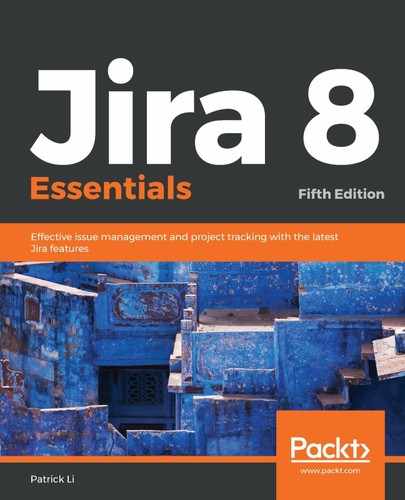Once the team has prioritized the issues and started a sprint during the sprint-planning meeting, the agile board will switch over to the active sprint view. For normal teams, you will have one active sprint at any given time, and your SCRUM board will look as follows:

On the SCRUM board, each issue is represented as a card, and the board itself is made up of vertical columns that represent the various states an issue can be in, and they are mapped to the workflow that's used by the project. So, in our example, we have the default workflow with three states, To Do, In Progress, and Done. As we will see later, the project administrator will be able to customize this. Team members move the issue card across the board into the appropriate columns as they work and complete their tasks.
The board can also be divided into a number of horizontal rows called swimlanes. These help you group similar issues and make your board easier to understand. In our example, we are grouping issues into swimlanes based on the issue assignee. Just like columns, the project administrator can customize how swimlanes should be defined.
When a sprint is underway, it is important to avoid introducing scope creep by adding more issues to the sprint, and it falls on the Scrum master and the product owner to make sure that the team is not distracted or blocked by any impediments. However, from time to time, emergency situations that demand certain features or fixes that need to be included do arise, and in these cases, you can add new issues into the active sprint from the backlog view.
Do keep in mind, though, that this should not become a common habit, as it is a distraction, and it is usually a sign of bad sprint planning or poor communication with stakeholders. For this reason, Jira will prompt you whenever you try to add more issues to an active sprint, as shown in the following screenshot:

At the end of the sprint, you need to complete the sprint by doing the following:
- Go to the SCRUM board and click on Active sprints.
- Click on the Complete Sprint link, as shown in the following screenshot:
- Click on the Complete button to finish the sprint.

Once you have completed a sprint in Jira, any unfinished issues will be placed back into the backlog. Sometimes, you may have other sprints that are planned but not active; in this case, issues that are not completed from the current active sprint can be automatically added to the next available sprint.
It can be tempting to extend the sprint for just a few more days because you have just one more issue to complete. While this is not a hard rule, you should generally avoid this and just let the incomplete issue go back to the backlog and reprioritize it during the next sprint meeting. This is because Scrum is an iterative process, and the goal is not to make everyone work as hard as possible, but to be able to retrospectively look at what the team did right and/or wrong in the previous sprint and address that in the next sprint. Perhaps the reason for this is because of an inaccurate estimation or incorrect assumptions that were made during requirement gathering. The point here is that the team should view this as an opportunity to improve rather than a failure to be rushed through. Simply extending the current sprint to accommodate incomplete items can turn into a slippery slope where the practice of extending sprints becomes the norm and the root problem is masked.
